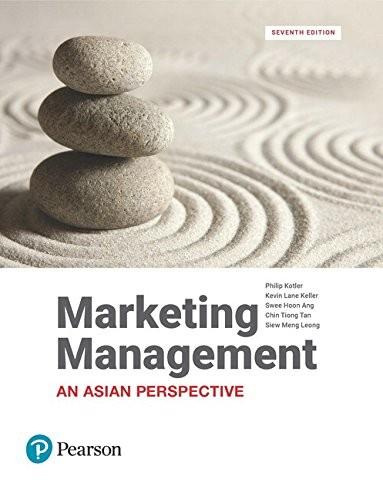Brief Contents
About this Book xviii
Preface xxi
PART 1 Understanding Marketing Management 2
Chapter 1 Defining Marketing for the New Realities 2
1.1 The Importance of Marketing 4
1.2 The Scope of Marketing 4
1.2.1 What is Marketing? 4
1.2.2 What is Marketed? 5
1.2.3 Who Markets? 8
1.3 Core Marketing Concepts 10
1.3.1 Needs, Wants, and Demands 10
1.3.2 Target Markets, Positioning, and Segmentation 11
1.3.3 Offerings and Brands 11
1.3.4 Value and Satisfaction 12
1.3.5 Marketing Channels 12
1.3.6 Supply Chain 12
1.3.7 Competition 12
1.3.8 Marketing Environment 13
1.4 The New Marketing Realities 13
1.4.1 Major Societal Forces 13
1.4.2 New Company Capabilities 15
1.4.3 Marketing in Practice 15
MARKETING MEMO Reinventing Marketing At Coca-Cola 16
1.5 Company Orientation Toward the Marketplace 17
1.5.1 The Production Concept 17
1.5.2 The Product Concept 17
1.5.3 The Selling Concept 17
1.5.4 The Marketing Concept 17
1.5.5 The Holistic Marketing Concept 18
1.6 Updating the Four P’s 22
MARKETING INSIGHT Understanding The 4 A’s of Marketing 23
1.7 Marketing Management Tasks 24
1.7.1 Developing Marketing Strategies and Plans 24
MARKETING MEMO Marketers’ Frequently Asked Questions 25
1.7.2 Capturing Marketing Insights and Performance 25
1.7.3 Connecting with Customers 25
1.7.4 Building Strong Brands 25
1.7.5 Shaping the Market Offerings 26 1.7.6 Delivering Value 26 1.7.7 Communicating Value 26 1.7.8 Creating Successful Long-Term Growth 26 Summary 27
Applications 29
MARKETING LESSON Modern Creation München (MCM) 30
MARKETING LESSON Google 33
Chapter 2 Developing Marketing Strategies and Plans 36 2.1 Marketing and Customer Value 38 2.1.1 The Value Delivery Process 38 2.1.2 The Value Chain 38
MARKETING INSIGHT The Value of WhatsApp to Facebook 39 2.1.3 Core Competencies 40 2.1.4 The Central Role of Strategic Planning 41 MARKETING MEMO What Does it Take to Be a Successful CMO? 41 2.2 Corporate and Division Strategic Planning 42 2.2.1 Defining the Corporate Mission 42 2.2.2 Establishing Strategic Business Units (SBUs) 44 2.2.3 Assigning Resources to Each SBU 45 2.2.4 Assessing Growth Opportunities 46 2.2.5 Organization and Organizational Culture 48 2.2.6 Marketing Innovation 50
MARKETING INSIGHT Creating Innovative Marketing 51 2.3 Business Unit Strategic Planning 52 2.3.1 The Business Mission 52 2.3.2 SWOT Analysis 52
MARKETING MEMO Checklist for Performing Strengths/ Weaknesses Analysis 54 2.3.3 Goal Formulation 55 2.3.4 Strategic Formulation 56 2.3.5 Program Formulation and Implementation 57 2.3.6 Feedback and Control 58 2.4 Product Planning: The Nature and Contents of a Marketing Plan 58
MARKETING MEMO Marketing Plan Criteria 59
2.4.1 The Role of Research 60
2.4.2 The Role of Relationships 60
2.4.3 From Marketing Plan to Marketing Action 60
Summary 61
Applications 63
MARKETING LESSON TWG Tea 64
MARKETING LESSON Yum! Brands 66
Sample Marketing Plan: Pegasus Sports International 69
PART 2 Capturing Marketing Insights 74
Chapter 3 Gathering Information and Forecasting Demand 74
3.1 Components of a Modern Marketing Information System 76
3.2 Internal Records and Marketing Intelligence 77
3.2.1 The Order-to-Payment Cycle 77
3.2.2 Sales Information Systems 77
3.2.3 Databases, Data Warehousing, and Data Mining 77
MARKETING INSIGHT Making Big Data Work for You 78
3.2.4 The Marketing Intelligence System 78
3.2.5 Collecting Marketing Intelligence on the Internet 79
3.2.6 Communicating and Acting on Marketing Intelligence 80
3.3 Analyzing the Macroenvironment 80
3.3.1 Needs and Trends 80
MARKETING INSIGHT Ten Forces Forging China’s Future 81
3.3.2 Identifying the Major Forces 82
3.3.3 The Demographic Environment 82
MARKETING INSIGHT Finding Gold at the bottom of the Pyramid 84
3.3.4 Economic Environment 87
3.3.5 Social-Cultural Environment 90
3.3.6 Natural Environment 92
MARKETING INSIGHT The Green Marketing Revolution 93
3.3.7 Technological Environment 94
3.3.8
Political-Legal Environment 95
3.4 Forecasting and Demand Measurement 97
3.4.1 The Measures of Market Demand 97
3.4.2 A Vocabulary for Demand Measurement 98
3.4.3
Estimating Current Demand 100
3.4.4 Estimating Future Demand 102
Summary 104
Applications 106
MARKETING LESSON Microsoft 107
MARKETING LESSON Uber 109
Chapter 4 Conducting Marketing Research 112
4.1 The Marketing Research System 114
4.2 The Marketing Research Process 115
4.2.1 Step 1: Define the Problem, the Decision Alternatives, and the Research Objectives 115
4.2.2 Step 2: Develop the Research Plan 116
MARKETING MEMO Conducting Informative Focus Groups 117
MARKETING MEMO Questionnaire Do’s and Don’ts 120
MARKETING INSIGHT Getting into Consumers’ Heads With Qualitative Research 121
MARKETING INSIGHT Understanding Brain Science 122
4.2.3 Step 3: Collect the Information 125
4.2.4 Step 4: Analyze the Information 125
4.2.5 Step 5: Present the Findings 125
4.2.6 Step 6: Make the Decision 125
4.3 Marketing Research in Asia 126
4.4 Measuring Marketing Productivity 128
4.4.1 Marketing Metrics 128
4.4.2 Marketing-Mix Modeling 129
4.4.3 Marketing Dashboards 129
MARKETING INSIGHT Marketing Dashboards to Improve Effectiveness and Efficiency 130
Summary 132
Applications 134
MARKETING LESSON Nestlé Malaysia: Lactogen 4 135
MARKETING LESSON Procter & Gamble 139
PART 3
Chapter 5
Connecting with Customers 142
Creating Customer Value, Satisfaction, and Loyalty 142
5.1 Building Customer Value, Satisfaction, and Loyalty 144
5.1.1
Customer Perceived Value 144
5.1.2 Total Customer Satisfaction 149
5.1.3 Monitoring Satisfaction 149
5.1.4 Product and Service Quality 150
5.2 Maximizing Customer Lifetime Value 152
5.2.1 Customer Profitability 152
5.2.2 Measuring Customer Lifetime Value 153
5.2.3 Attracting and Retaining Customers 153
MARKETING MEMO Calculating Customer Lifetime Value 154
MARKETING INSIGHT Seven Lessons from Samsung’s Note 7 Crisis 155
5.2.4 Building Loyalty 158
5.2.5 Win-Backs 160
5.3 Cultivating Customer Relationships 160
5.3.1
Customer Relationship Management (CRM) 160
MARKETING INSIGHT The Behavioral Targeting Controversy 161
Summary 164
Applications 166
MARKETING LESSON Food Scandals in Taiwan: The Case of Tin Hsin International Group 167
MARKETING LESSON Tesco 170
Chapter 6 Analyzing Consumer Markets 172
6.1 What Influences Consumer Behavior? 174
6.1.1 Cultural Factors 174
6.1.2 Social Factors 175
MARKETING INSIGHT Face-saving and the Chinese Consumer 177
6.1.3 Personal Factors 178
6.2 Key Psychological Processes 181
6.2.1 Motivation: Freud, Maslow, Herzberg 181
6.2.2 Perception 183
MARKETING MEMO The Power of Sensory Marketing 183
6.2.3
Learning 186
6.2.4 Emotions 187
6.2.5 Memory 188
6.3 The Buying Decision Process: The Five-Stage Model 190
6.3.1
Problem Recognition 190
6.3.2 Information Search 190
6.3.3 Evaluation of Alternatives 191
6.3.4 Purchase Decisions 194
6.3.5 Postpurchase Behavior 195
6.3.6
6.4
Moderating Effects on Consumer Decision Making 197
Behavioral Decision Theory and Behavioral Economics 198
6.4.1 Decision Heuristics 198
6.4.2 Framing 199
6.4.3 Mental Accounting 200
Summary 201
Applications 205
MARKETING LESSON Hello Kitty 206
MARKETING LESSON Gold Misses 209
Chapter 7 Analyzing Business Markets 214
7.1 What is Organizational Buying? 216
7.1.1 The Business Market versus the Consumer Market 216
7.1.2 Buying Situations 217
7.2 Participants in the Business Buying Process 218
7.2.1 The Buying Center 218
7.2.2 Buying Center Influences 219
7.2.3 Targeting Firms and Buying Centers 219
7.3 The Purchasing/Procurement Process 220
7.4 Stages in the Buying Process 221
7.4.1 Problem Recognition 221
7.4.2 General Need Description and Product Specification 222
7.4.3 Supplier Search 222
MARKETING INSIGHT The Asian B2B Environment 223
7.4.4 Proposal Solicitation 224
7.4.5 Supplier Selection 224
MARKETING MEMO Developing Compelling Customer Value Propositions 225
7.4.6 Order-Routine Specification 226
7.4.7 Performance Review 227
7.5 Developing Effective Business-to-Business Marketing Programs 227
7.5.1 Communication and Branding Activities 227
7.5.2 Systems Buying and Selling 228
MARKETING MEMO Spreading the Word With Customer Reference Programs 229
7.5.3 Role of Services 229
7.6 Managing Business-to-Business Customer Relationships 230
MARKETING INSIGHT Rules of Social and Business Etiquette 230
7.6.1 The Benefits of Vertical Coordination 231
MARKETING INSIGHT Establishing Corporate Trust, Credibility, and Reputation 232
7.6.2 Business Relationships: Risks and Opportunism 233
7.7 Relationship Marketing in the Keiretsu and Chaebol 234
7.8 Institutional and Government Markets 234
Summary 237 Applications 239
MARKETING LESSON Tagit 240
MARKETING LESSON Accenture 244
Chapter 8 Identifying Market Segments and Targets 246
8.1 Bases for Segmenting Consumer Markets 248
8.1.1 Geographic Segmentation 249
8.1.2 Demographic Segmentation 250
8.1.3 Psychographic Segmentation 253
8.1.4 Behavioral Segmentation 255
8.2 Bases for Segmenting Business Markets 258
8.3 Market Targeting 259
8.3.1 Effective Segmentation Criteria 260
8.3.2 Evaluating and Selecting the Market Segments 261
MARKETING INSIGHT Segmentation Strategy for China 263
MARKETING INSIGHT Chasing the Long Tail 265
Summary 267
Applications 269
MARKETING LESSON PT Heinz ABC 270
MARKETING LESSON Fulla Dolls: The Alternative Barbie 272
PART 4
Building Strong Brands 274
Chapter 9 Creating Brand Equity 274
9.1 How Does Branding Work? 276
9.1.1 The Role of Brands 276 9.1.2 The Scope of Branding 278 9.2 Defining Brand Equity 278
9.2.1 Brand Equity Models 281 9.3 Building Brand Equity 284 9.3.1 Choosing Brand Elements 285
MARKETING INSIGHT Driving Deeper Brand Connection in China 289
9.3.2 Designing Holistic Marketing Activities 290
9.3.3 Brand Communities 291 9.3.4 Leveraging Secondary Association 292 9.4 Measuring Brand Equity 294
MARKETING INSIGHT The Brand Value Chain 294
MARKETING INSIGHT What is a Brand Worth? 296 9.5 Managing Brand Equity 296
9.5.1 Brand Reinforcement 296
9.5.2 Brand Revitalization 297 9.6 Devising a Branding Strategy 298
9.6.1 Branding Decisions 299
9.6.2 Brand Portfolios 300
9.6.3 Brand Extensions 302 9.7 Customer Equity 305
MARKETING MEMO 21st Century Branding 306
Summary 307
Applications 310
MARKETING LESSON Malaysian Airlines 311
MARKETING LESSON McDonald’s 314
Chapter 10 Crafting the Brand Positioning 316
10.1 Developing and Communicating a Positioning Strategy 318
10.1.1 Understanding Positioning and Value Propositions 318
10.2 Determining a Competitive Frame of Reference 319
10.2.1 Identifying Competitors 319
10.2.2 Analyzing Competitors 320
10.2.3 Identifying Optimal Points-of-Parity and Pointsof-Difference 320
10.2.4 Choosing Specific POPs and PODs 324
10.3 Brand Mantras 326
10.3.1 Role of Brand Mantras 326
10.3.2 Designing a Brand Mantra 327
10.4 Establishing Brand Positioning 328
10.4.1 Communicating Category Membership 328
MARKETING MEMO Constructing a Brand Positioning Bull’s-eye 329
10.4.2 Communicating POPs and PODs 330
10.4.3 Monitoring Competition 330
10.5 Alternative Approaches to Positioning 331
10.5.1 Brand Narratives and Storytelling 331
10.5.2 Cultural Branding 332
10.6 Positioning and Branding a Small Business 332
Summary 334 Applications 336
MARKETING LESSON Under Armour 337
MARKETING LESSON Nike China 339
Chapter 11 Competitive Dynamics 344
11.1 Competitive Strategies for Market Leaders 346
MARKETING INSIGHT Pokémon Go: A Game-Changer for Nintendo? 346
11.1.1 Expanding Total Market Demand 347
11.1.2 Protecting Market Share 349
MARKETING INSIGHT Sun Tzu Bing Fa: Modern Strategy Insights from Ancient China 350
11.1.3 Increasing Market Share 354
11.2 Other Competitive Strategies 355
11.2.1
11.2.2
Market-Challenger Strategies 356
Market-Follower Strategies 358
MARKETING INSIGHT Counteracting Counterfeiting 359
11.2.3 Market-Nicher Strategies 360
MARKETING MEMO Niche Specialist Roles 361 11.3 Product Life-Cycle Marketing Strategies 361
11.3.1 Product Life Cycles (PLC) 362 11.3.2 Style, Fashion, and Fad Life Cycles 362
11.3.3 Marketing Strategies: Introduction Stage and the Pioneer Advantage 363
MARKETING INSIGHT Understanding Double Jeopardy 364
11.3.4
Marketing Strategies: Growth Stage 366 11.3.5
Marketing Strategies: Maturity Stage 367 11.3.6 Marketing Strategies: Decline Stage 369 11.3.7 Evidence for the Product Life-Cycle Concept 370 11.3.8 Critique of the Product Life-Cycle Concept 371
11.3.9 Market Evolution 371 11.4 Marketing in a Slow-Growth Economy 372 11.4.1 Explore the Upside of Increasing Investment 372
11.4.2 Get Closer to Customers 372 11.4.3 Review Budget Allocations 372
11.4.4 Put Forth the Most Compelling Value Proposition 373
11.4.5 Fine-tune Brand and Product Offerings 373 Summary 374 Applications 377
MARKETING LESSON Tata Salt (A) 378
MARKETING LESSON Tata Salt (B) 382
PART 5 Shaping the Market Offerings 384
Chapter 12 Setting Product Strategy 384
12.1 Product Characteristics and Classifications 386
12.1.1 Product Levels: The Customer-Value Hierarchy 386 12.1.2 Product Classifications 387 x Contents
12.2 Differentiation 389
12.2.1 Product Differentiation 389
12.2.2 Services Differentiation 391
12.3 Design 393
12.4 Luxury Products 394
12.4.1 Characterizing Luxury Brands 394
12.4.2 Growing Luxury Brands 395
12.4.3 Marketing Luxury Brands 395
12.5 Environmental Issues 397
MARKETING MEMO A Sip or A Gulp: Environmental Concerns in the Water Industry 398
12.6 Product and Brand Relationships 398
12.6.1 The Product Hierarchy 398
12.6.2 Product Systems and Mixes 399
12.6.3 Product-Line Analysis 400
12.6.4 Product-Line Length 401
MARKETING INSIGHT When Less Is More 402
12.6.5 Product-Mix Pricing 405
MARKETING MEMO Product-Bundle Pricing Considerations 407
12.6.6 Co-Branding and Ingredient Branding 407
12.7 Packaging, Labeling, and Warranties and Guarantees 409
12.7.1 Packaging 409
12.7.2 Labeling 412
12.7.3 Warranties and Guarantees 412 Summary 413 Applications 416
MARKETING LESSON Nintendo 417
MARKETING LESSON Toyota 419
Chapter 13 Designing and Managing Services 422
13.1 The Nature of Services 424
13.1.1 Service Industries Are Everywhere 424
13.1.2 Categories of Service Mix 424
13.1.3 Distinctive Characteristics of Services 426
13.2 The New Service Realities 430
13.2.1 A Shifting Customer Relationship 430
MARKETING INSIGHT The Japanese Philosophy of Service 432
13.3 Achieving Excellence in Services Marketing 433
13.3.1 Marketing Excellence 433 13.3.2 Technology and Service Delivery 434
MARKETING INSIGHT Tapping Technology for Service Excellence: Henn-na Hotel 434
13.3.3 Service in Asia 435 13.3.4 Best Practices of Top Service Companies 436
MARKETING MEMO Service Excellence: Five Pointers from SIA 436
13.3.5 Differentiating Services 440 13.4 Managing Service Quality 441
MARKETING MEMO Recommendations for Improving Service Quality 443
13.4.1 Managing Customer Expectations 443 13.4.2 Incorporating Self-Service Technologies (SSTs) 446
13.5 Managing Product-Support Services 446
13.5.1 Identifying and Satisfying Customer Needs 447
13.5.2 Post-Sale Service Strategy 447 Summary 449 Applications 451
MARKETING LESSON Shangri-La Bosphorus Hotel 452
MARKETING LESSON Singapore Airlines 456
Chapter 14 Developing Pricing Strategies and Programs 458
14.1 Understanding Pricing 460
14.1.1 Pricing in a Digital World 460
MARKETING INSIGHT Giving It All Away 461
14.1.2 A Changing Pricing Environment 461 14.1.3 How Companies Price 462
14.1.4 Consumer Psychology and Pricing 463
14.2 Setting the Price 466
14.2.1 Step 1: Selecting the Pricing Objective 466
MARKETING INSIGHT Trading Up, Down, and Over 467
14.2.2 Step 2: Determining Demand 469
14.2.3 Step 3: Estimating Costs 472
14.2.4 Step 4: Analyzing Competitors’ Costs, Prices, and Offers 475
14.2.5 Step 5: Selecting a Pricing Method 476
14.2.6 Step 6: Selecting the Final Price 480
MARKETING INSIGHT Stealth Price Increases 481
14.3 Adapting the Price 482
14.3.1 Geographical Pricing (Cash, Countertrade, Barter) 482
14.3.2 Price Discounts and Allowances 483
14.3.3 Promotional Pricing 484
14.3.4 Differentiated Pricing 484
14.4 Initiating and Responding to Price Changes 485
14.4.1 Initiating Price Cuts 485
14.4.2 Initiating Price Increases 486
14.4.3 Responding to Competitors’ Price Changes 487
Summary 489
Applications 492
MARKETING LESSON Siam Park City 493
MARKETING LESSON eBay 497
PART 6 Delivering Value 500
Chapter 15 Designing and Managing Marketing Channels and Value Networks 500
15.1 Marketing Channels and Value Networks 502
15.1.1 The Importance of Channels 502
15.1.2 Multichannel Marketing 503
15.1.3 Integrating Multichannel Marketing Systems 503
15.1.4 Value Networks 504
15.1.5 The Digital Channels Revolution 505
15.2 The Role of Marketing Channels 505
15.2.1 Channel Functions and Flows 505
15.2.2 Channel Levels 507
15.2.3 Service Sector Channels 509
15.3 Channel-Design Decisions 509
15.3.1 Analyzing Customer Needs and Wants 509
MARKETING INSIGHT Understanding the Showrooming Phenomena 510
15.3.2 Establishing Objectives and Constraints 511
15.3.3 Identifying Major Channel Alternatives 513
15.3.4 Evaluating the Major Alternatives 515
15.4 Channel-Management Decisions 517
15.4.1
15.4.2
15.4.3
Selecting Channel Members 517
Training and Motivating Channel Members 517
Evaluating Channel Members 520
15.4.4 Modifying Channel Design and Arrangements 520
15.4.5 Global Channel Considerations 521
15.5 Channel Integration and Systems 521
15.5.1 Vertical Marketing Systems 521
15.5.2 Horizontal Marketing Systems 523
15.6 E-Commerce Marketing Practices 523
15.6.1 Pure-Click Companies 523
15.6.2 Brick-and-Click Companies 526
15.7 M-Commerce Marketing Practices 526
15.7.1 Changes in Customer and Company Behavior 526
15.7.2 Marketing Practices 526
MARKETING MEMO Lessons from South Korea’s MobileRetailers 527
15.8 Conflict, Cooperation, and Competition 528
15.8.1 Types of Conflict and Competition 528
15.8.2 Causes of Channel Conflict 528
15.8.3 Managing Channel Conflict 529
15.8.4 Dilution and Cannibalization 529
15.8.5 Legal and Ethical Issues in Channel Relations 530 Summary 532 Applications 536
MARKETING LESSON 7-Eleven 537
MARKETING LESSON Taobao 541
Chapter 16 Managing Retailing, Wholesaling, and Logistics 544
16.1 Retailing 546
16.1.1 Types of Retailers 546
MARKETING INSIGHT Enhancing Online Shopping in Asia 548
16.1.2 The Modern Retail Marketing Environment 549
MARKETING INSIGHT Franchise Fever in Asia 550
16.1.3 Marketing Decisions 553
MARKETING INSIGHT The Growth of Shopper Marketing 554
MARKETING MEMO Helping Stores to Sell 559
MARKETING INSIGHT Feng Shui and Its Application to Retailing and Marketing in the Far East 561
16.2 Private Labels 562
16.2.1 Role of Private Labels 562
16.2.2
Private Label Success Factors 563
MARKETING INSIGHT Manufacturer’s Response to the Private Label Threat 564
16.3 Wholesaling 564
16.3.1 Trends in Wholesaling 565
16.4 Market Logistics 565
16.4.1 Integrated Logistics Systems 566
16.4.2 Market-logistics Objectives 567
16.4.3 Market-logistics Decisions 568
Summary 570 Applications 572
MARKETING LESSON Shanghai Tang 573
MARKETING LESSON Amazon.com 577
PART 7 Communicating Value 580
Chapter 17 Designing and Managing Integrated Marketing Communications 580
17.1 The Role of Marketing Communications 582
17.1.1 The Changing Marketing Communications Environment 582
17.1.2 Marketing Communications and Brand Equity 582
17.1.3 The Communications Process Models 585
17.2 Developing Effective Communications 587
17.2.1 Identify the Target Audience 587
17.2.2 Set the Communications Objectives 588
17.2.3 Design the Communications 588
MARKETING INSIGHT Celebrity Endorsements as a Message Strategy 591
MARKETING INSIGHT Collectivism, Consensus Appeals, and Credibility 592
17.2.4 Select the Communications Channels 592
17.2.5 Establish the Total Marketing Communications Budget 594
17.3 Selecting the Marketing Communications Mix 596
MARKETING INSIGHT Marketing Communications and the Chinese Consumer 597
17.3.1 Characteristics of the Marketing Communications Mix 597
17.3.2 Factors in Setting the Marketing Communications Mix 600
17.3.3 Measuring Communication Results 601
17.4 Managing the Integrated Marketing Communications Process 602
17.4.1 Coordinating Media 602
17.4.2 Implementing IMC 603
MARKETING MEMO How Integrated Is Your IMC Program? 603
Summary 604 Applications 607
MARKETING LESSON Red Bull 608
MARKETING LESSON Target 610
Chapter 18 Managing Mass Communications: Advertising, Sales Promotions, Events, and Public Relations 612
18.1 Developing and Managing an Advertising Program 614
18.1.1 Setting the Advertising Objectives 614
18.1.2 Deciding on the Advertising Budget 615
18.1.3 Developing the Advertising Campaign 616
MARKETING INSIGHT Safi Rania Gold 618
MARKETING INSIGHT Advertising Guidelines for Modern Asia 619
MARKETING MEMO Print Ad Evaluation Criteria 621
18.2 Choosing Media 622
18.2.1 Reach, Frequency, and Impact 622
18.2.2 Choosing among Major Media Types 623
18.2.3 Place Advertising Options 624
MARKETING INSIGHT Playing Games with Brands 626
18.2.4 Evaluating Advertising Effectiveness 628
18.3 Sales Promotion 630
MARKETING INSIGHT Alibaba’s Singles’ Day Phenomenon Sets Sights on Going Global 630
18.3.1 Concerns with Promotion 631
18.3.2 Major Decisions 632
18.4 Events and Experiences 637
MARKETING INSIGHT Brands and Sport Sponsorship 637
18.4.1 Events Objectives 639
18.4.2 Major Sponsorship Decisions 640
MARKETING MEMO Measuring High Performance Sponsorship Programs 641
18.4.3 Creating Experiences 642
18.5 Public Relations 642
18.5.1 Marketing Public Relations 643
18.5.2 Major Decisions in Marketing PR 644
Summary 646 Applications 649
MARKETING LESSON Gillette (A) 650
MARKETING LESSON Gillette (B) 654
Chapter 19 Managing Digital Communications: Online, Social Media, and Mobile 656
19.1 Online Marketing 658
19.1.1 Advantages and Disadvantages of Online Marketing Communications 658
MARKETING INSIGHT Asia’s Technologically Savvy Shoppers 659
19.1.2 Online Marketing Communication Options 659
MARKETING MEMO How to Maximize the Marketing Value of Emails 662
19.2 Social Media 663
19.2.1 Social Media Platforms 663
19.2.2 Using Social Media 664
19.3 Word of Mouth 665
19.3.1 Forms of Word of Mouth 665
19.3.2 Creating Word-of-Mouth Buzz 665
MARKETING MEMO How To Start A Buzz Fire 667
19.3.3 Measuring the Effects of Word of Mouth 667
MARKETING INSIGHT Tracking Online Buzz 668
19.4
Mobile Marketing 668
19.4.1 The Scope of Mobile Marketing 668
19.4.2 Developing Effective Mobile Marketing Programs 669
19.4.3 Mobile Marketing across Markets 669 Summary 671 Applications 672
MARKETING LESSON Facebook 673
MARKETING LESSON Unilever (Axe and Dove) 675
Chapter 20 Managing Personal Communications: Direct and Database Marketing and Personal Selling 678
20.1 Direct Marketing 680
20.1.1 The Benefits of Direct Marketing 680
20.1.2 Direct Mail 681
20.1.3 Catalog Marketing 682
20.1.4 Telemarketing 683
20.1.5 Public and Ethical Issues in Direct Marketing 683
20.2 Customer Databases and Database Marketing 684
20.2.1 Customer Databases 684
20.2.2 Data Warehouses and Data Mining 684
20.2.3 The Downside of Database Marketing 686
20.3 Designing the Sales Force 687
20.3.1 Sales Force Objectives and Strategy 688
20.3.2 Sales Force Structure 689
MARKETING INSIGHT Major Account Management 690
20.3.3 Sales Force Size 690
20.3.4 Sales Force Compensation 691
20.4 Managing the Sales Force 692
20.4.1 Recruiting and Selecting Representatives 692
20.4.2 Training and Supervising Sales Representatives 692
20.4.3 Sales Rep Productivity 693
20.4.4 Motivating Sales Representatives 694
20.4.5 Evaluating Sales Representatives 695
20.5 Principles of Personal Selling 697
20.5.1 The Six Steps 698
20.5.2 Negotiation 699
20.5.3 Relationship Marketing 701
MARKETING INSIGHT Culture and Relationship Marketing 702
Summary 705
Applications 708
MARKETING LESSON Progressive 709
MARKETING LESSON Victoria’s Secret 711
PART 8 Creating Successful Long-Term Growth 714
Chapter 21 Introducing New Market Offerings 714
21.1 New-Product Options 716
21.1.1 Make or Buy 716
21.1.2 Types of New Products 716
21.2 Challenges in New-Product Development 717
21.2.1 The Innovation Imperative 717
MARKETING INSIGHT Lessons from Google in Creating an Innovative Culture 718
21.2.2 New-Product Success 719
21.2.3 New-Product Failure 720
21.2.4 Asian Perspective of New-Product Development 721
21.3 Organizational Arrangements 721
21.3.1 Budgeting for New-Product Development 722
21.3.2 Organizing New-Product Development 722
21.4 Managing the Development Process: Ideas 724
21.4.1 Generating Ideas 724
MARKETING MEMO Ten Ways to Great New-Product Ideas 725
MARKETING INSIGHT New-Idea Generation in Japanese Companies 725
MARKETING INSIGHT P&G’s New CONNECT + DEVELOP Approach to Innovation 726
MARKETING MEMO Seven Ways to Draw New Ideas from Your Customers 727
MARKETING MEMO How to Run a Successful Brainstorming Session 729
21.5 Managing the Development Process: Concept to Strategy 731
21.5.1 Concept Development and Testing 731
21.5.2 Marketing Strategy Development 734
21.5.3 Business Analysis 735
21.6 Managing the Development Process: Development to Commercialization 736
21.6.1 Product Development 737
21.6.2 Market Testing 737
21.6.3 Commercialization 740
21.7 The Consumer-Adoption Process 742
21.7.1 Stages in the Adoption Process 742
21.7.2 Factors Influencing the Adoption Process 742 Summary 746 Applications 750
MARKETING LESSON Apple 751
MARKETING LESSON Tiger Balm 753
Chapter 22 Tapping into Global Markets 758
22.1 Competing on a Global Basis 760
22.2 Deciding Whether to Go Abroad 761
22.3 Deciding Which Markets to Enter 762
22.3.1 How Many Markets to Enter 762
22.3.2 Evaluating Potential Markets 763
22.3.3 Succeeding in Developing Markets 764
MARKETING INSIGHT Heinz’s Four A’s for Emerging Market Expansion 767
MARKETING INSIGHT How Chinese Brands can Gain Global Acceptance 770
22.4 Deciding How to Enter the Market 771
22.4.1 Indirect and Direct Export 771
22.4.2 Licensing 772
22.4.3 Joint Ventures 773
MARKETING INSIGHT Guanxi and Its Application to Marketing in Greater China 774
22.4.4 Direct Investment 775
22.5 Deciding on the Marketing Program 776
22.5.1 Global Similarities and Differences 777
22.5.2 Marketing Adaptation 778
MARKETING MEMO The Ten Commandments Of Global Branding 779
22.5.3 Global Product Strategies 780
22.5.4 Global Communication Strategies 783
22.5.5 Global Pricing Strategies 785
22.5.6 Global Distribution Strategies 787
22.6 Country-of-Origin Effects 789
22.6.1 Building Country Images 789
22.6.2 Consumer Perceptions of Country of Origin 790
Summary 792
Applications 795
MARKETING LESSON L’Oréal 796
MARKETING LESSON Volkswagen 798
Chapter 23 Managing a Holistic Marketing Organization 802
23.1 Trends in Marketing Practices 804
23.2 Internal Marketing 805
23.2.1 Organizing the Marketing Department 805
MARKETING MEMO Characteristics of Customer-Driven Company Departments 806
23.2.2 Relations with Other Departments 809
23.2.3 Building a Creative Marketing Organization 810
23.3 Socially Responsible Marketing 810
MARKETING INSIGHT The Marketing CEO 810
23.3.1 Corporate Social Responsibility 812
23.3.2 Socially Responsible Business Models 815
MARKETING INSIGHT Confucius and Marketing in East Asia 815
23.3.3 Cause-Related Marketing 816
MARKETING MEMO Making a Difference: Top 10 Tips for Cause Branding 817
23.3.4 Social Marketing 818
23.4 Marketing Implementation and Control 820
23.4.1 Marketing Implementation 820
23.4.2 Marketing Control 821
23.5 The Future of Marketing 827
MARKETING MEMO Major Marketing Weaknesses 827
Summary 829
Applications 832
MARKETING LESSON Unilever Platinum Stores 833
MARKETING LESSON Timberland 837
Appendix Tools for Marketing Control 839
Appendix A1 Endnotes E1 Glossary G1 Image Credits C1 Name Index I1 Company, Brand, and Organization Index I11
Subject Index II3
Asian concepts and practices
Students are kept up-to-date with and informed of the concepts and practices in Asia.
• Islamic marketing
• Guanxi
Economic, environmental and technological
An emphasis on 3 key marketing changes–economic,
• Online marketing helpsstudentsto understand
• Marketing during economic downturns and recessions
• The rise of sustainability and
• The increased development of computing power, the Internet, and mobile phones. environmental, and technological social responsibility
This page intentionally left blank
What’s New in the Seventh Edition
Welcome to the seventh edition of Marketing Management: An Asian Perspective. With the seventh edition, a great care was taken to truly reflect the modern realities of marketing in Asia brought on by technology and the increasing role of social responsibility; while in selected parts of Asia, culture and heritage nuances suggest adaptation of marketing practices.
Throughout the text, three broad forces—growth and downturns, technology, and social responsibility—are identified as critical to the success of marketing programmes. These three topics are evident throughout the text.
As has been the case for a number of editions now, the overriding goal of the revision for the seventh edition of Marketing Management: An Asian Perspective is to create as comprehensive, current, and engaging a marketing textbook as possible. Wherever appropriate, new materials have been added, old materials updated, and no longer relevant or necessary material removed.
While marketing is changing in many significant ways, yet many core elements remain. We feel that a balanced approach of classic and contemporary approaches and perspectives is the way to go. Marketing Management: An Asian Perspective seventh edition allows instructors to build on what they have prepared for teaching previously while at the same time offering a text that is unsurpassed in breadth, depth, and relevance for students experiencing Marketing Management: An Asian Perspective for the first time.
Many of the favourably received chapter features such as topical chapter opening vignettes, in-text boxes highlighting noteworthy companies or issues, and the Marketing Insight and Marketing Memo boxes that provide in-depth conceptual and practical commentary, have been retained.
At the end of each chapter, the Summary page consolidates the students’ knowledge and serves as a speedy revision tool.
The organizational structure of Marketing Management: An Asian Perspective has largely been preserved although several adjustments have been made to improve student understanding, as described below.
Significant changes to the seventh edition include:
• Brand-new opening vignettes for over 80 per cent of the chapters set the stage for the chapter material to follow. By covering topical brands or companies, the vignettes are great classroom discussion starters.
• Almost half of the in-text boxes are new. These boxes provide vivid illustrations of chapters using actual companies and situations. The boxes cover a variety of products, services, and markets. Marketing Insight boxes include contemporary issues such as “The Value of Whatsapp to Facebook.” They also delve into important marketing topics such as the use of technology in services marketing in “Tapping on Technology for Service Excellence: Henn-na Hotel” and developing effective brand names in “Driving Deeper Brand Connection in China.” Marketing Memo boxes offer practical advice and direction in dealing with various decisions at all the stages of the marketing management process. Topics covered include “Lessons from South Korea’s Mobile Retailers” and “Service Excellence: Five Pointers from SIA.”
• Several of the in-text box materials are from Think Business, the knowledge portal of the National University of Singapore Business School, which carries a wide range of business articles and videos.
• Each end-of-chapter section includes two expanded Marketing Lessons for case problem solving. Over 75 per cent of Marketing Lessons are new cases. The rest have been updated. These cases highlight challenges that companies face in Asia as well as innovative, insightful marketing accomplishments by leading organizations that businesses, including those in Asia, can learn from. Each case includes questions that promote classroom discussion and analysis. Almost all the cases are new. They include companies such as MCM, Yum, Uber, Unilever, 7-Eleven, Heinz, and Nintendo.
• A brand new Chapter 19 on Managing Digital Communications: Online, Social Media, and Mobile gives the deserved attention to the impact of the digital revolution on marketing.
What Is Marketing Management All About?
Changes are observed in the marketing discipline like fundamental topics such as segmentation, targeting, and positioning as well as concepts such as brand equity, customer value analysis, database marketing, e-commerce, value networks, hybrid channels, supply chain management, and integrated marketing communications.
Asian businesses must acknowledge and respond to the new elements in today’s marketplace. Firms now sell goods and services through a variety of direct and indirect channels. Mass advertising is not nearly as effective as it was, so marketers are exploring new forms of communication, such as experiential, entertainment, and viral marketing. Asian consumers are telling companies what types of product or services they want and when, where, and how they want to buy them. They are increasingly reporting to other consumers what they think of specific companies and products—using email, blogs, and other digital media to do so. Company messages are becoming a smaller fraction of the total “conversation” about products and services.
In response, forward-thinking Asian companies are shifting gears from managing product portfolios to managing customer portfolios. They are compiling databases on individual customers to better understand them and to construct individualized offerings and messages. They are doing less product and service standardization and more niching and customization and are replacing monologues with customer dialogues. They are improving their methods of measuring customer profitability and customer lifetime value. They are measuring the return on their marketing investment and its impact on shareholder value. Ethical and social implications of their marketing decisions are also their area of concern.
As companies change, so does their marketing organization. Marketing is no longer a company department charged with a limited number of tasks—it is a company-wide undertaking. It drives the company’s vision, mission, and strategic planning. Marketing includes decisions like who the company wants as its customers; which of their needs to satisfy; what products and services to offer; what prices to set; what communications to send and receive; what channels of distribution to use; and what partnerships to develop. Marketing succeeds only when all departments work together to achieve goals: when engineering designs the right products, finance furnishes the required funds, purchasing buys high-quality materials, production makes high-quality products on time, and accounting measures the profitability of different customers, products, and areas.
To address all these different shifts, good marketers are practicing holistic marketing. Holistic marketing is the development, design, and implementation of marketing programs, processes, and activities that recognize the breadth and interdependencies of today’s marketing environment. Four key dimensions of holistic marketing are:
1. Internal marketing—ensuring everyone in the organization embraces appropriate marketing principles, especially senior management.
2. Integrated marketing—ensuring that multiple means of creating, delivering, and communicating value are employed and combined in the best way.
3. Relationship marketing—having rich, multifaceted relationships with customers, channel members, and other marketing partners.
4. Performance marketing—understanding returns to the business from marketing activities and programs, as well as addressing broader concerns and their legal, ethical, social, and environmental effects.
These four dimensions are woven throughout the book and at times spelled out explicitly. The text specifically addresses the following tasks that constitute modern marketing management:
1. Developing marketing strategies and plans
2. Capturing marketing insights
3. Connecting with customers
4. Building strong brands
5. Creating value
6. Delivering value
7. Communicating value
8. Conducting marketing responsibly for long-term success
What Makes Marketing Management the Marketing Leader?
As marketing has maintained its respected position among students, educators, and businesspeople, Marketing Management: An Asian Perspective has kept up-to-date and remains contemporary. Students (and instructors) feel that the book is talking directly to them in terms of both content and delivery.
Marketing Management: An Asian Perspective owes its marketplace success to its ability to maximize three dimensions that characterize the best marketing texts—depth, breadth, and relevance—as measured by the following criteria:
• Depth. Does the book have solid academic grounding? Does it contain important theoretical concepts, models, and frameworks? Does it provide conceptual guidance to solve practical problems?
• Breadth. Does the book cover all the right topics? Does it provide the proper amount of emphasis on those topics?
• Relevance. Does the book engage the reader? Is it interesting to read? Does it have lots of compelling examples?
This seventh edition builds on the fundamental strengths of past editions that collectively distinguish it from all other marketing management texts:
• Managerial Orientation. The book focuses on the major decisions that marketing managers and top management face in their efforts to harmonize the organization’s objectives, capabilities, and resources with marketplace needs and opportunities.
• Analytical Approach. Marketing Management: An Asian Perspective presents conceptual tools and frameworks for analyzing recurring problems in marketing management. Cases and examples illustrate effective marketing principles, strategies, and practices.
• Multidisciplinary Perspective. The book draws on the rich findings of various scientific disciplines—economics, behavioral science, management theory, and mathematics—for fundamental concepts and tools directly applicable to marketing challenges.
• Universal Applications. The book applies strategic thinking to the complete spectrum of marketing: products, services, persons, places, information, ideas and causes; consumer and business markets; profit and nonprofit organizations; domestic and foreign companies; small and large firms; manufacturing and intermediary businesses; and low and hightech industries.
• Asian Insights. This book provides insights with an Asian flavour, drawing from regional thinkers and business leaders (from Confucius and Sun Tzu to Jong-Yong Yun and Carlos Ghosn, among others), institutions (chaebol, keiretsu, and so on), Asian trends and events (China’s reliance on its domestic market, demographic changes, etc.), and practices that impact Asian marketing (guanxi, mianzi, feng shui, counterfeiting, etc.).
• Comprehensive and Balanced Coverage. Marketing Management: An Asian Perspective covers all the topics an informed marketing manager needs to understand to execute strategic, tactical, and administrative marketing.
The Teaching and Learning Package
Marketing Management: An Asian Perspective is an entire package of materials available to students and instructors. This edition includes a number of ancillaries designed to make the marketing management course an exciting, dynamic, interactive experience.
INSTRUCTOR’S MANUAL
The Instructor’s Manual includes chapter/summary overviews, key teaching objectives, answers to end-of-chapter materials, exercises, projects, and detailed lecture outlines. Also included is the feature, “Professors on the Go!” which was created with the busy professor in mind. It brings key material upfront, where an instructor who is short on time can find key points and assignments that can be incorporated into the lecture, without having to page through all the material provided for each chapter.
TEST ITEM FILE
The Test Item File contains more than 3,000 multiple-choice, true-false, short-answer, and essay questions, with page reference and difficulty level provided for each question. Please note that an entire section is dedicated to application questions. These real-life situations take students beyond basic chapter concepts and vocabulary and ask them to apply marketing skills.
The Test Item File supports Association to Advance Collegiate Schools of Business (AACSB) International Accreditation. Each chapter of the Test Item File was prepared with the AACSB curricula standards in mind. Where appropriate, the answer line of each question* indicates a category within which the question falls. This AACSB reference helps instructors identify those test questions that support that organization’s learning goals.
*Please note that not all the questions will offer an AACSB reference.
POWERPOINT SLIDES
Teaching slides are available for easy customization and sharing.
The seventh edition of Marketing Management: An Asian Perspective bears the imprint of many people. Our colleagues at the Kellogg Graduate School at Northwestern University, Dartmouth College, the National University of Singapore Business School, and the Singapore Management University continue to have an impact on our thinking. We also want to thank our respective academic leaders, Deans Dipak Jain at Kellogg, Paul Danos at Tuck, and Bernard Yeung at National University of Singapore Business School for their continuous support of our research and writing efforts.
The talented staff at Pearson Education—particularly Steven Jackson and Ishita Sinha— deserve praise for their role in shaping this book. We thank Elison A.C. Lim and MingMin Yeh, Institute of Asian Consumer Insight, Nanyang Business School, for contributing the case “Food Scandals in Taiwan: The Case of Tin Hsin International Group”; Dae Ryun Chang, Yonsei School of Business, and Kevin Sproule, Singapore Management University, for contributing the case “Gold Misses”; Desai Narasimhalu and Sarita Mathur, Singapore Management University, for contributing the case “Tagit”; Philip Zerrillo, Havovi Joshi, and S. N. Venkat, Singapore Management University for contributing the cases “Tata Salt (A)” and “Tata Salt (B)”; Srinivas Reddy and Havovi Joshi, Singapore Management University for contributing the case “Shangri-La Bosphorus Hotel”; Philip C. Zerillo and Sarita Mathur, Singapore Management University, and Pannapachr Itthiopassagul, Thammasat University for contributing the cases “Siam Park City” and “Unilever”; Srinivas Reddy and Christopher Dula, Singapore Management University for contributing the case “Gillette (A)”; Srinivas Reddy, Christopher Dula, and Adina Wong for contributing the case “Gillette (B)”; Doreen Kum, National University of Singapore Business School while she was at Singapore Management University for contributing the case “Tiger Balm”; Steven Wyatt and Christopher Dula, Singapore Management University for contributing the case “Shanghai Tang”. Our overriding debt continues to be to our families, who provided the time, support, and inspiration to prepare this edition.
We are grateful to the following individuals and companies for providing us permission to use some of the materials for this book:
Banyan Tree Hotels and Resorts
BMW of North America
Center for Insurance Studies
Clear Channel Singapore
Eu Yan Sang International Ltd.
Essilor Singapore
Frito-Lay, Inc.
Groupe Danone
Haier America
Haw Par Healthcare Limited
Hotel Mume
Hyundai Motor Company
LG Electronics Chile Ltd
Lion Corporation (S) Pte Ltd.
Mindbody Inc.
Mondo USA Inc.
Sigg Switzerland AG
NTUC Fairprice Cooperative Limited
Nu Skin Innovation Center
Singapore Cancer Society
Smooth E Company Limited
The Coca-Cola Company
The Gatorade Company
Tourism Bureau of Ministry of Transportation and Communications, R.O.C








































































